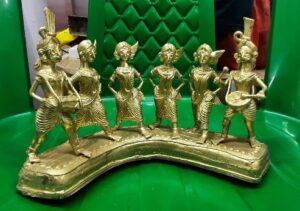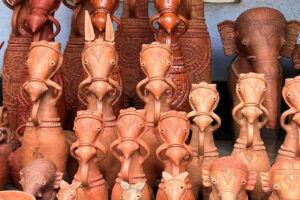The untold story of ‘Kantha’ and ‘Kantha Stitch’ of Bengal

Kantha, one of the oldest forms of embroidery from India and a craft practiced today by millions of South Asian women, originated from a humble beginning.
While the word kantha has no certain etymological root, it is believed to be derived from the Sanskrit word kantha, meaning rags. One of the oldest forms of embroidery originating from India, its origins can be traced back to the pre-Vedic age (prior to 1500 BCE), though the earliest written record is found dating 500 years ago. In his book titled Sri Sri Chaitanya Charitamrita, poet Krishnadas Kaviraj writes how the mother of Chaitanya Mahaprabhu sent a homemade kantha to her son in Puri through some traveling pilgrims. This same kantha is till date on display at Gambhira in Puri.
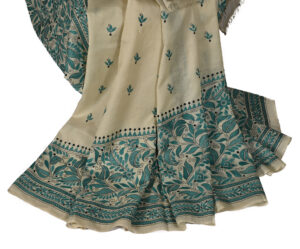 Born in the rural villages of Bengal as an object of daily life, this art form never had a commercial usage till it was revived and positioned in the 1940s by the daughter-in-law of the famed Bengali poet and Nobel laureate, Rabindranath Tagore in Shantiniketan. She visualized the enormous potential in the art form and repositioned it as an indigenous article of desire for art lovers and thus providing a livelihood for the poor rural women folk who prepare it.
Born in the rural villages of Bengal as an object of daily life, this art form never had a commercial usage till it was revived and positioned in the 1940s by the daughter-in-law of the famed Bengali poet and Nobel laureate, Rabindranath Tagore in Shantiniketan. She visualized the enormous potential in the art form and repositioned it as an indigenous article of desire for art lovers and thus providing a livelihood for the poor rural women folk who prepare it.
 Kantha (also spelled katha, and qanta) is a type of embroidery craft practiced in the eastern region of Indian subcontinent, found specifically in the states of West Bengal, Tripura and some parts of Odisha. It’s also found in Bangladesh. Traditionally, old and used saris were stacked on each other and hand-stitched using the coloured thread from the border of sarees’ to make a thin piece of cushion. These were normally used above a bed as cushion or as a thin quilt to keep you warm in early winter days. In fact, it was an old-age recycling process in every household of Bengal and Village women liberated their creative minds in making lovely motifs and designs through this simple run stitches.
Kantha (also spelled katha, and qanta) is a type of embroidery craft practiced in the eastern region of Indian subcontinent, found specifically in the states of West Bengal, Tripura and some parts of Odisha. It’s also found in Bangladesh. Traditionally, old and used saris were stacked on each other and hand-stitched using the coloured thread from the border of sarees’ to make a thin piece of cushion. These were normally used above a bed as cushion or as a thin quilt to keep you warm in early winter days. In fact, it was an old-age recycling process in every household of Bengal and Village women liberated their creative minds in making lovely motifs and designs through this simple run stitches.
These simple stitching style evolved over decades and became famous as “Kantha stitch” and are presently practiced to create different apparel like Saree, Salwar Suit, Kurta and Churidar and many other garments and gaining huge popularity due to their aesthetic value and fine handmade artistry. Present-day kantha stitch is used on different exotic fabric like Tassaur Silk, Muga, or Bangalore Silk or simple cotton with complex and exotic design (Naksha) and thus called Nakshi-Kantha which gained high popularity within India and abroad.
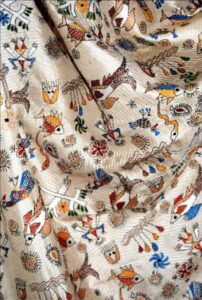 Kantha is very popular with elite tourists visiting the Bengal specially Shantiniketan region of the India.
Kantha is very popular with elite tourists visiting the Bengal specially Shantiniketan region of the India.
As with all traditional textiles, the recycling of well used cloth-turned-rags was a natural step in the lifecycle of textiles the world over. Given that this recycling was home-based work, it usually fell to the women of the village to prepare, cut and stitch the rags – giving old textiles new life.
Traditionally, old cotton saris, lungis and dhotis, which had turned incredibly soft through wear, were used to make kanthas, with the thread for the stitching drawn out from the fabric itself. Recycling at its best! Collection from Srejonee
Women in almost every household in rural villages would be kantha experts, and spend whatever quiet time they had available – between looking after the house and children, tending to livestock and during the long days of the monsoon – on stitching the pieces. It could take months or even years to complete one kantha. The stitching could be handed down through generations, with grandmother, mother and daughter working on the same kantha.
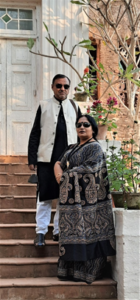
Register Now
The Kantha Stitch
In modern usage, kantha more generally refers specifically to the type of stitch used. The earliest and most basic kantha stitch is a simple, straight, running stitch, like the type used on our Kantha Scarves.
Over time, more elaborate patterns developed, which became known as
“nakshi kantha”.
Elaborately designed Nakshi Kantha saree on pure Murshidabad silk is the first choice of the present-day elite. Shop the Srejonee collection
Nakshi comes from the Bengali word, naksha, which refers to artistic patterns. Nakshi kantha is made up of motifs influenced by religion, culture and the lives of the women stitching them. Village women from Birbhum district of Bengal stitching Kantha sarees’ in groups.
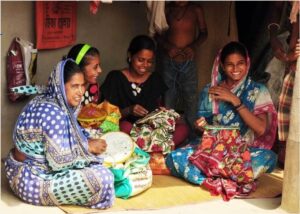
This most humble of cloths gave free reign to the imaginations of the women; kanthas told of folk beliefs and practices, religious ideas, themes and characters from mythology
and epics and the social and personal lives of the artisans; their dreams, hopes and every day village life. Although there is no strict symmetry to nakshi kantha, a fine piece will usually have a lotus as a focal point, with stylized birds, plants, fish, flowers and other scenes surrounding this.
Kantha Artist today have excelled in stitching an entire village scene with every perfection like a paint on a canvas. Shop from www.srejonee.com WhatsApp No: 7439906048
Srejonee team is working closely with the artisans and women self help groups of rural Bengal to bring out the best and most authentic Kantha Stitch articles to our elite customers world over.
Please log on to www.srejonee.com and register yourself to select from our exclusive collection and book your order.
References: www.wanderingsilk.org; www.wikipedia.org

